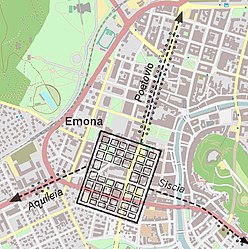
Back Emona BS Emona Catalan Emona Czech Emona Welsh Colonia Emona German Ήμονα Greek Emona Spanish امونا Persian Emona (Ljubljana) French Aemona Croatian
| Colonia Iulia Aemona | |
|---|---|
 Location of Emona in modern Ljubljana | |
| Alternative name(s) | Emona, Aemona |
| Type | Castrum, Colonia (after 43 AD) |
| Place in the Roman world | |
| Province | Italia |
| Administrative unit | Venetia et Histria |
| Limes | Claustra Alpium Iuliarum |
| Directly connected to | |
| Structure | |
| — Stone structure — | |
| Built during the reign of | Second Triumvirate, Gaius Calvisius Sabinus, Lucius Marcius Censorinus |
| Built | 35 BC |
| Size and area | 540 m × 430 m (23.2 ha) |
| Shape | Rectangular |
| Stationed military units | |
| — Legions — | |
| |
| Events | 35 BC - AD 43, Colonia AD 43 - 452 |
| Location | |
| Coordinates | 46°2′51.7″N 14°30′3.32″E / 46.047694°N 14.5009222°E |
| Place name | Ljubljana |
| Town | Ljubljana |
| County | City Municipality of Ljubljana |
| Country | Slovenia |
| Site notes | |
| Condition | Ruined |
| Exhibitions | City Museum of Ljubljana |
| Website | www |
Emona (early Medieval Greek: Ἤμονα)[1] or Aemona (short for Colonia Iulia Aemona) was a Roman castrum, located in the area where the navigable Nauportus[2] River came closest to Castle Hill,[3] serving the trade between the city's settlers – colonists from the northern part of Roman Italy – and the rest of the empire. Emona was the region's easternmost city,[4] although it was assumed formerly that it was part of the Pannonia or Illyricum, but archaeological findings from 2008 proved otherwise. From the late 4th to the late 6th century, Emona was the seat of a bishopric that had intensive contacts with the ecclesiastical circle of Milan, reflected in the architecture of the early Christian complex along Erjavec Street in present-day Ljubljana.
The Visigoths camped by Emona in the winter of 408/9, the Huns attacked it during their campaign of 452, the Langobards passed through on their way to Italy in 568, and then came incursions by the Avars and Slavs. The ancient cemetery in Dravlje indicates that the original inhabitants and invaders were able to live peacefully side by side for several decades. After the first half of the 6th century, there was no life left in Emona.[3] The 18th-century Ljubljana Renaissance elite shared the interest in Antiquity with the rest of Europe, attributing the founding of Ljubljana to the mythical Jason and the Argonauts.[3] Other ancient Roman towns located in present-day Slovenia include Nauportus (now Vrhnika), Celeia (now Celje), Neviodunum (now the village of Drnovo) and Poetovio (now Ptuj).
- ^ "Sozomenos, Ecclesiastical History, §1.6". Archived from the original on 2020-08-15. Retrieved 2020-02-01.
- ^ Kos, Marjeta Šašel (2015). The Disappearing Tombstone and Other Stories from Emona. Založba ZRC. p. 6. ISBN 978-9612547646.
- ^ a b c Exhibition catalogue Emona: myth and reality Archived 2013-11-05 at the Wayback Machine; Museum and Galleries of Ljubljana 2010
- ^ Šašel Kos, M. (2002) "The boundary stone between Aquileia and Emona", Arheološki Vestnik 53, pp. 373–382.
© MMXXIII Rich X Search. We shall prevail. All rights reserved. Rich X Search
